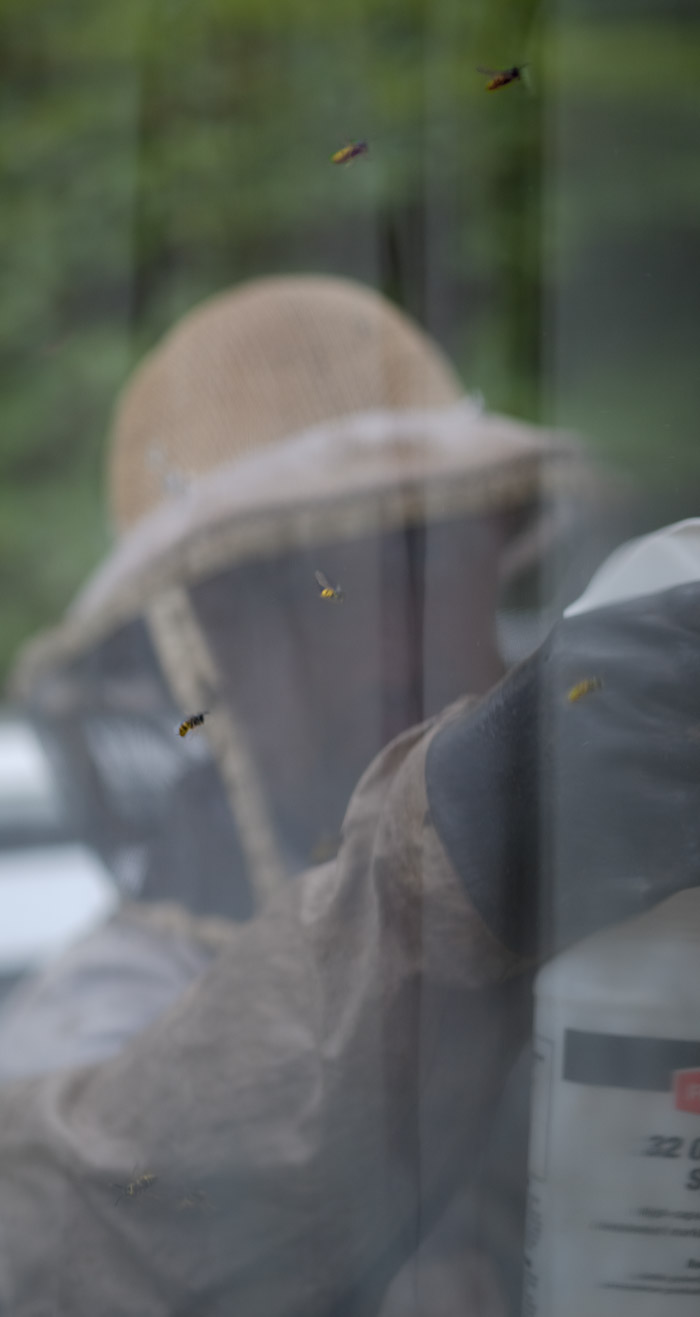Stingers
Aug 10, 2014
 Above, in Seattle, getting rid of yellow jackets who've nested in the wall of the house beneath the shingles; below, in Philly, not yet getting rid of a wasp nest high in a tree on Kater Street.
Above, in Seattle, getting rid of yellow jackets who've nested in the wall of the house beneath the shingles; below, in Philly, not yet getting rid of a wasp nest high in a tree on Kater Street.
Aug 10, 2014
 Above, in Seattle, getting rid of yellow jackets who've nested in the wall of the house beneath the shingles; below, in Philly, not yet getting rid of a wasp nest high in a tree on Kater Street.
Above, in Seattle, getting rid of yellow jackets who've nested in the wall of the house beneath the shingles; below, in Philly, not yet getting rid of a wasp nest high in a tree on Kater Street.
Mar 3, 2016
 Clearly, if you want a job doing news in front of a TV camera, you have to have that glow, along with blonde hair that stays perfectly in place even in the winds of March.
Clearly, if you want a job doing news in front of a TV camera, you have to have that glow, along with blonde hair that stays perfectly in place even in the winds of March.
These women were reporting on Wednesday's Supreme Court arguments in a Texas case severely curtailing access to abortion. In front of the Court building, they were surrounded by demonstrators, an estimated fifteen hundred championing reproductive rights and another few dozen with bullhorns screaming about God and whores.
Below are a couple of scenes of the demonstration, including some notable handwritten protest signs: "Not every ejaculation needs a name," and our personal favorite, "Why are we still talking about this?"
Apr 6, 2016
 This crane has been caught in the act of growing itself. The object it's lifting into the air is a 20-foot section of crane-tower that it is about to swing into place to lengthen its own neck and make itself taller. The new section will be inserted at the top of the neck, which is currently at a level near the top of the building, where a sort of cage structure surrounds the tower.
This crane has been caught in the act of growing itself. The object it's lifting into the air is a 20-foot section of crane-tower that it is about to swing into place to lengthen its own neck and make itself taller. The new section will be inserted at the top of the neck, which is currently at a level near the top of the building, where a sort of cage structure surrounds the tower.
This cage is called a climbing frame, and it costs $60,000 to rent for a weekend. For a crane that wants to grow itself, the climbing frame is the secret to the whole pulling-itself-up-by-its-own-bootstraps thing.
The climbing frame is installed around the top of the crane's neck, just below the horizontal part of the crane, which does all the heavy lifting. The horizontal arm, with its gears and motor, has to be unbolted from the tower and settled onto the top of the climbing frame. Hydraulic jacks in the frame then boost it up, leaving a gap in the tower. The crane simply picks up a new section of tower and slips it into the gap.
Over the course of a few hours on Monday, this crane grew by six sections, 120 feet. We're told it's now as tall as it needs to be for the project–condos, of course, along the Schuylkill riverfront. In June, the crane guys say they'll be back to dismantle the whole thing and move it to its next job.
How will it ungrow itself? It can't. It's not a cannibal. Sometimes the crane will haul up a second, smaller crane onto the roof of the finished building, and the smaller crane will then lower the pieces of the big crane. To get the second crane down, they sometimes have to use a third, even smaller crane, which can be disassembled into pieces small enough to go down the elevator.
Feb 6, 2017
 Blowing on a bird's belly–in this case, a common yellowthroat warbler–can reveal a lot of useful information.
Blowing on a bird's belly–in this case, a common yellowthroat warbler–can reveal a lot of useful information.
For example: Is she currently setting on a nestful of eggs? If so, then blowing back the feathers around her belly will reveal a patch of unfeathered skin. This is the brood patch; when mama bird settles down on the nest, her warm belly skin is in direct contact with the eggs, incubating them. Soon after they hatch, her brood patch will disappear.
And while you've got a bird in hand, you might as well spread out the wing feathers, as seen below on a spotted towhee, to learn the bird's age and get an idea of how many miles it's clocked:
More than two million times since 1989, through an ongoing program known as MAPS, scientists and volunteers at thousands of stations across Canada and the U.S. have captured wild birds, identified them by species, blown on their bellies and spread out their feathers and noted dozens of critical characteristics related to age and health, and then fixed tiny numbered bands around skinny little bird ankles and let them fly free.
The bird below is being fitted for its new ankle band:
Very early one morning last July, these birds and more than 50 others were trapped for banding at Morse Wildlife Preserve, near the headwaters of the north fork of Muck Creek, south of Tacoma, Washington. Three of the birds had been banded previously, and another three were banded that morning and then recaptured the same day.
Before dawn, the banding crew set up fine-mesh nets, known as mist nets, in a dozen clearings in the spruce forest and overgrown farmland at the preserve.
Banders checked the nets every fifteen minutes until about noon, and almost always, they found little birds snarled in the mesh. Very young birds may try to squirm their way out, but all the others hang immobile in the net, apparently in shock. We're told that the shock can be fatal, so banders try to un-net the birds gently but quickly; risk is greatest early in the morning, before the day has warmed up, when some birds may require warming under the banders' shirts. But such problems are exceedingly rare, and almost all the birds are released unharmed.
No one is allowed to touch these birds until completing comprehensive training in bird identification, handling, measurements, and other data-gathering, An early lesson involves the proper way to hold a captured bird, such as this common yellowthroat:
Over the years, bird banding for the MAPS program–Monitoring Avian Productivity and Survivorship–has vastly improved our knowledge of bird migration patterns and has begun to focus on the links between bird populations and climate change. Banding teams return to each station every few days throughout the summer breeding season; the Morse preserve has participated in MAPS for almost twenty years.
Some MAPS banding is now high-tech, using miniaturized GPS transmitters that are now so small they can be attached to the legs of birds who weigh as little as 3 ounces, such as robins. Some MAPS stations now collect feathers for DNA sequencing. But the Morse program is old-school; the bands are tiny numbered strips of aluminum, and all the data associated with each band number–species, sex, age, body fat, condition of wing feathers, etc., etc., etc.–is entered by hand into logsheets on clipboards.
Although a bird in hand is a whole lot easier to identify than one on the wing or in a distant bush, the banding worktable was loaded with books and notebooks full of reference materials. For identification of birdsong, the banders had apps on their phones.
Not all species were bandable; hummingbirds, for example, were logged in and then released unbanded. We were told that teensy little hummingbird bands do exist, but handling them requires special certication. Two hummingbirds were caught that morning at Morse:
This freshly banded junco posed for a picture before flying off to get on with its life:
Mar 25, 2018
 Our friends and neighbors who live in University House Wallingford joined the nationwide anti-gun/anti-Trump protest Saturday, braving the cold and the traffic to make sure their voices were heard.
Our friends and neighbors who live in University House Wallingford joined the nationwide anti-gun/anti-Trump protest Saturday, braving the cold and the traffic to make sure their voices were heard.
Most University House residents are in their eighties or nineties. At least one of the protesters is a centenarian. Some of them rarely leave home on foot, wary of the neighborhood's uneven sidewalks. But this was important.
They held up handmade posters calling for gun control and school safety, taking up positions at a major intersection where Saturday shoppers would have to take notice.
Cars honked in their honor. Pedestrians thanked them. One storekeeper distributed gifts–well, gag gifts, since that was the store's specialty: little plastic fingers they could use for pointing at their signs.
Another neighbor, who'd ventured out to the grocery store for a gallon of milk, bought candy bars for all the protesters.
Time will tell how the politicians will respond.